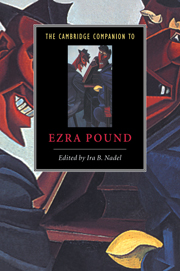Book contents
- Frontmatter
- 1 Introduction Understanding Pound
- 2 Pound and the making of modernism
- 3 Early poetry 1908-1920
- 4 Early Cantos I-XLI
- 5 Middle Cantos XLII-LXXI
- 6 Late Cantos LXXII-CXVII
- 7 Beyond The Cantos
- 8 The texts of The Cantos
- 9 Pound as critic
- 10 Pound as translator
- 11 Pound and the visual arts
- 12 Pound and music
- 13 Pound's politics and economics
- 14 Pound, women and gender
- 15 Pound and antisemitism
- Further reading
- Index
3 - Early poetry 1908-1920
Published online by Cambridge University Press: 28 May 2006
- Frontmatter
- 1 Introduction Understanding Pound
- 2 Pound and the making of modernism
- 3 Early poetry 1908-1920
- 4 Early Cantos I-XLI
- 5 Middle Cantos XLII-LXXI
- 6 Late Cantos LXXII-CXVII
- 7 Beyond The Cantos
- 8 The texts of The Cantos
- 9 Pound as critic
- 10 Pound as translator
- 11 Pound and the visual arts
- 12 Pound and music
- 13 Pound's politics and economics
- 14 Pound, women and gender
- 15 Pound and antisemitism
- Further reading
- Index
Summary
Writing of W. B. Yeats at the end of the 1930s, T. S. Eliot described him as “born into a world in which the doctrine of 'Art for Art's sake' was generally accepted, and living on into one in which art has been asked to be instrumental to social purposes.” Eliot and his contemporaries experienced this transition as well. Like Yeats and Ruskin before him, they had somehow to reconcile the competing claims of aestheticism and social commitment. The early poetry of Ezra Pound registers this tension vividly, as it oscillates between the worship of beauty and the reform of culture. Through many changes of style, from the fin-de-siècle romanticism of A Lume Spento (1908) to the hard-edged satire of Hugh Selwyn Mauberley (1920), Pound's writing served this double imperative.
From the age of fifteen, Pound says in a memoir entitled "How I Began" (1913), he knew that he was to be a poet. Moreover, he was to be a national epic poet, on the model of Homer, Dante and Whitman. His mother encouraged him to write an epic of the American West, and the early poem entitled "Scriptor Ignotus" speaks prophetically of "that great forty-year epic/That you know of, yet unwrit" (CEP, 24-5). The young man from Hailey, Idaho, and Wyncote, Pennsylvania, embraced as his destiny a high romantic ideal of the poet as bard, prophet, sage, and visionary seer. In this paradigm, the service of art and the service of society are one.
- Type
- Chapter
- Information
- The Cambridge Companion to Ezra Pound , pp. 43 - 58Publisher: Cambridge University PressPrint publication year: 1999
- 3
- Cited by



